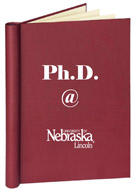Graduate Studies, UNL

Dissertations and Doctoral Documents from University of Nebraska-Lincoln, 2023–
First Advisor
Forrest M. Kievit
Degree Name
Doctor of Philosophy (Ph.D.)
Department
Agricultural and Biological Systems Engineering
Date of this Version
8-2024
Document Type
Dissertation
Citation
A dissertation presented to the faculty of the Graduate College of the University of Nebraska in partial fulfillment of requirements for the degree of Doctor of Philosophy
Major: Biological Engineering
Under the supervision of Professor Forrest M. Kievit
Lincoln, Nebraska, August 2024
Abstract
The clinical translation of nanoparticle (NP) therapeutics for brain injury has been slow despite preclinical promise. The causes of disconnect between preclinical and clinical outcomes is multifactorial, but insufficient delivery is noteworthy. Preclinical delivery characterization often lacks, obscuring mechanisms of failure, slowing development. Multimodal imaging is a promising strategy to improve delivery characterization, combining the strengths of various modalities. Magnetic resonance imaging (MRI) and luminescence imaging are a suitable combination for multimodal imaging, expanding the spatial and temporal resolution of either alone, but further material development is needed to enhance detectability. One problem is the interference of cellular autofluorescence in luminescence imaging. The use of sensitized lanthanide luminophores, with emission lifetimes multiple orders of magnitude longer than autofluorescence, has been shown as an effective interference mitigation strategy in small molecule chelates as well as NP systems.
This dissertation covers the assessment of several surface-coordinating ligands for enhanced photoluminescence of ultrasmall Eu2O3 NPs. Among the tested species, quinaldic acid (QA) and kynurenic acid (KA) were previously unreported for the sensitization of NPs, while terephthalic acid (TA) was previously used in a different Eu NP model. NP characterization showed consistent core structure, effective ligand coordination, and enhancement of Eu3+ emissions over tissue lysate autofluorescence. TA, QA, and KA provided signal-to-tissue-noise fold enhancements of 75, 89, and 108, respectively with time-gating. KA was further investigated as a co-sensitizer with DPA to enable the UV-A excitation of KA while passivating the surface with DPA to enhance emission intensity and lifetime. Using KA with DPA enhanced Eu3+ emission relative to tissue lysate autofluorescence, providing a 797-fold increase with time-gating. Comparison of that co-sensitized NP to Rhodamine B in a model of mounted tissue imaging showed a 15-fold improvement in detection limit on a number concentration basis. This work showed the efficacy of Eu sensitization with novel species, and it motivates further investigation toward mixed Gd/Eu NPs for multimodal imaging.
Advisor: Forrest M. Kievit
Recommended Citation
Miller, Hunter A., "Nanoparticle-based Approaches to Brain Injury and Studies for Improved Detectability toward Better Delivery Characterization" (2024). Dissertations and Doctoral Documents from University of Nebraska-Lincoln, 2023–. 181.
https://digitalcommons.unl.edu/dissunl/181
Included in
Nanoscience and Nanotechnology Commons, Neurology Commons, Therapeutics Commons, Wounds and Injuries Commons


Comments
Copyright 2024, Hunter A. Miller. Used by permission